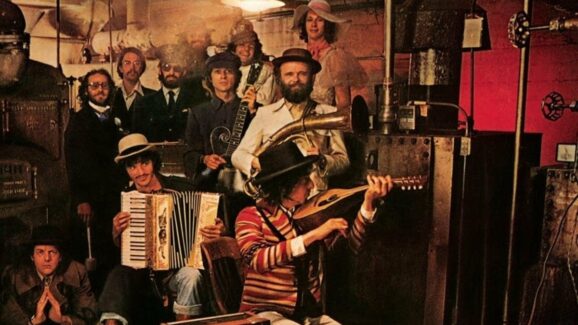[rating=4.00]
 Long celebrated for his ability to capture the mood of a specific American moment (New Jersey 1975, USA 1985, New York post 9/11,) Bruce Springsteen had his work cut out for him with his new album, Wrecking Ball. For such an earnest songwriter to strike a resonant tone in perhaps the greatest social, economic, and cultural upheaval in American history is no easy task. Few musicians carry the vast public expectations and emotional hopes for new albums like The Boss and with mistrust, irony, desperation, and boatloads of anger fomenting the country’s collective psychological breakdown, today’s America is as lost as ever. Wrecking Ball also follows the musical disappointment of 2009’s Working on A Dream, primarily remembered for that awesome Super Bowl crotch slide. With the scales tipped, our ever valiant and sincere Jersey hero comes through in the clutch by melding and re-commissioning the American traditions of Gospel and Soul in conversation with Appalachian instrumentation and melodies. A heaping dose of Celtic anger buoys the album with heat. Bruce is fired up.
Long celebrated for his ability to capture the mood of a specific American moment (New Jersey 1975, USA 1985, New York post 9/11,) Bruce Springsteen had his work cut out for him with his new album, Wrecking Ball. For such an earnest songwriter to strike a resonant tone in perhaps the greatest social, economic, and cultural upheaval in American history is no easy task. Few musicians carry the vast public expectations and emotional hopes for new albums like The Boss and with mistrust, irony, desperation, and boatloads of anger fomenting the country’s collective psychological breakdown, today’s America is as lost as ever. Wrecking Ball also follows the musical disappointment of 2009’s Working on A Dream, primarily remembered for that awesome Super Bowl crotch slide. With the scales tipped, our ever valiant and sincere Jersey hero comes through in the clutch by melding and re-commissioning the American traditions of Gospel and Soul in conversation with Appalachian instrumentation and melodies. A heaping dose of Celtic anger buoys the album with heat. Bruce is fired up.
This musical fusion begins in earnest with “Easy Money”. Chanted syllables, wild hand claps and foot stomping grooves create an updated, more sinister version of “Atlantic City” ‘s night on the town. As the protagonist and his lady go “lookin’ for easy money” Springsteen alludes to the precedent set by Wall Street. Without basic rules of decency we all go seeking an easy buck and the outcome won’t be pretty. As the spirited groove turns over and heads for home with a dynamic squall, Wrecking Ball finds its wheelhouse.
“Shackled and Drawn” plays as a companion piece to “Easy Money” as Bruce nods to Gospel and R n’ B by “sampling” UK vocalist Lyn Collins’ “Me and My Baby Got Our Own Thing Going”. He makes it his own by adding that spicy Celtic sauce and weaves cultures together through shared anger. Economic inequality shackles the 99%; we are “trudging through the muck in a world gone wrong” and “woke up this morning shackled and drawn”. The Boss wouldn’t be himself without offering hope in desperate times and he invites us back to our own strength during adversity by imploring; “pick up the rock son, carry it on”! Sing it loud and its impossible not to smile. This musical salvation is a career spanning calling card and it strikes again with banjos clamoring, sousaphones squawking and trumpets blazing. When in doubt, make a ruckus. “Death to My Hometown” keeps the wild rumpus going and sounds like a night out drinking with his good buddies, The Dropkick Murphys.
The ballad “Jack of All Trades” is uplifted by guest guitarist Tom Morello’s emotional playing but otherwise the song plays stilted and long. “This Depression” works more effectively and provides a voice to those who who fall into their anger with no outlet and find only deep sadness. A keyboard drone resounds in the background and mimics the lyrical mood. “Rocky Ground” employs the most drum loops since “Streets of Philadelphia” and works its proto-hip hop groove.
Springsteen misfires with his own form of irony, ”We Take Care of Our Own”. Already mistaken for a naïve, patriotic anthem, the song name checks American cities in a gimmicky way and the track feels antiseptic. Just as Ronald Reagan used the bombast of “Born in the USA” without appropriately listening to the lyrics, this song plays like patriotism in sound but has its tongue firmly in cheek. Unfortunately, some casual fans may miss the best of Wrecking Ball as this was chosen as the first single.
The title track, the only song ever written from the perspective of a sports stadium, is classic Bruce. Played as a metaphoric love song to the glory days of America burning in haze of tragic glory, a simple and forlorn keyboard line is note perfect. When Bruce sings “bring on your wrecking ball” Curt Ramm’s trumpet calls us to stand tall in inside the most challenging transformation. This is the loyal, loving Bruce, all vast hope in the face of deep trouble. As the splendor of what once was contracts, Bruce remains steadfast that we Rise Up. When the late Clarence Clemmons’s saxophone appears toward the end of “Land of Hope and Dreams” the fading notion that it will all work becomes just a little easier to take. Inside all the wide-eyed disillusion, if we withstand this one, we just may make it.












